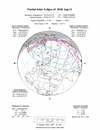![]()
- - text and links as of last publication - -
| CAUTION! OBSERVING A SUN ECLIPSE IS DANGEROUS AND MAY CAUSE IRREVERSIBLE EYE DAMAGE, UP TO BLINDNESS, ANNULAR AND PARTIAL ECLIPSES INCLUDED! Observing a Sun eclipse necessitates DEDICATED SAFE TECHNIQUES! |
That last solar eclipse in 2018 is a partial solar eclipse again, the partial solar eclipse of August 11th, 2018. A partial solar eclipse occurs when neither the 'umbra' nor the 'antumbra' of the eclipse touches Earth in any place as the 'penumbra' does, only. Anywhere in the area of a partial solar eclipse, observers are treated with a Sun indented by the dark disk of the Moon. for more about solar eclipses, theoretically, see our tutorial "Sun Eclipses"
That partial eclipse will be moving from West to East since Canada's northern territories to the limits of eastern Siberia and from Newfoundland to most of China. The greatest, by 09:46:19.0 UT, has the pecularity of occurring on the day/night terminator, close to the shores of Russia's Far East, with about a Sun's indentation of about 80 percent, which is very important. It will be the midnight Sun over those polar regions. The more away southwards, the less the Sun will be indented down to the eclipse's boundaries which will be located from Newfoundland to China, through southern Scandinavia and a part of Kazakhstan. The eclipse is seen against the background of constellation Leo, the Lion
 | A illustration of how a partial eclipse looks like either side of a total or annular, or per se; numbers match the one found on a eclipse's chart |
Eclipse's main data are the following (data as of November 2017, EclipseWise.com). The Moon's apparent diameter will be of 33' 20.0", compared to the Sun's 31' 33.6". Greatest eclipse
occurs in northern Antarctica at 09:46:19.0 UT. for more about how to observe a solar eclipse, see our tutorial 'Observing a Sun Eclipse':
- greatest eclipse: 09:46:19.0 UT
- eclipse magnitude (fraction of the Sun's diameter obscured by the Moon at greatest eclipse): 0.73677
- P1 to P4 (moments of first-last external-internal tangency of the penumbra with Earth's limb; practically these are the moments of the eclipse for the places where the eclipse is partial; no P2 nor P3 are given), in UT: P1 at 08:02:07.3, P4 at 11:30:44.5
 | see a map for the partial solar eclipse of August 11th, 2018. map courtesy EclipseWise.com |
. for more about this eclipse and for more about solar and lunar eclipses generally, you may see at the Internet, with Fred Espenak a reference in the domain
Website Manager: G. Guichard, site 'Amateur Astronomy,' http://stars5.6te.net. Page Editor: G. Guichard. last edited: 1/1/2019. contact us at geguicha@outlook.com